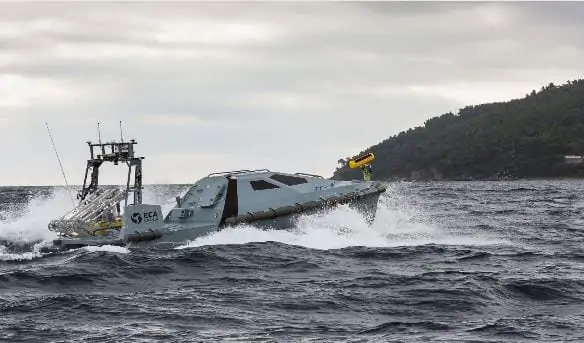ECA Group has announced that it has extended the capabilities of its INSPECTOR MK2 Unmanned Surface Vehicle (USV) to provide faster data transfer while linked to other unmanned systems. Premium equipment has been selected and tested in real-world conditions to complete and qualify ECA Group’s radio communication solutions for its USV range.
The INSPECTOR MK2 USV is now able to transfer data and communicate with other unmanned vehicles. With this new capability, the USV can be used as an intelligent docking system for underwater drones system such as AUVs or ROVs, allowing them to be automatically deployed and recovered. It enables recharging and data download, as well as fast transit.
Fitted with an acoustic modem and short baselines for underwater communications and positioning, the USV allows underwater inspection and intervention to be supervised by an operator based in a safe location. The USV’s sonar equipment also makes it an ideal platform for detection of mines as well as obstacles such as nets for safe AUV navigation.
These new communication solutions for the USV meet requirements such as:
- Adaptation/reconfiguration to the customer/mission characteristics, facilitated by compatibility with a multitude of antennas (directivity, gain), online reconfiguration according to Quality of Service, and latency vs. data rate real time mitigation
- Large frequency spectrum, from Ultra high frequency (UHF) to Super High Frequency (SHF)
- Variety of possible communication architectures: Point To Point (PTP), Point To Multi Point (PTMP), Multi Point Interconnection [MESH]
- Compliance with main standards: NATO, National, Civilian – Industrial Scientific and Medical band (ISM)
- Fulfilment of cybersecurity requirements
The USV wireless link provides the data bandwidth necessary to operate the USV and its mission modules up to a maximum Line Of Sight (LOS) distance (typically, with an ashore antenna height of 15 meters, a range of 10 nautical miles can be reached), or significant Non Line Of Sight (NLOS) range due to maritime traffic or land masking (typically, 10 nautical miles range is also reached despite a 50m height obstacle).
Find suppliers of Unmanned Surface Vehicles (USV) >



















